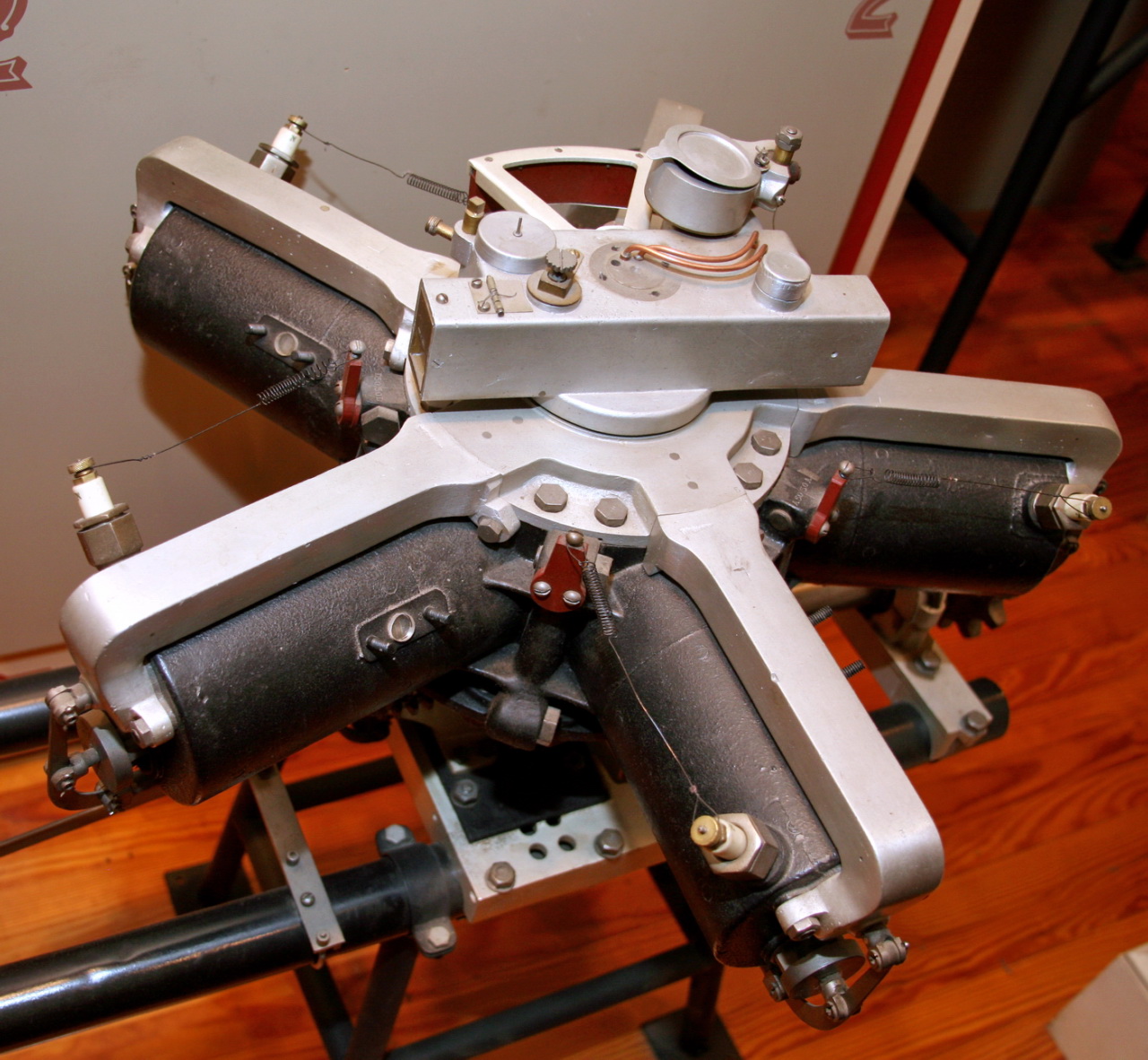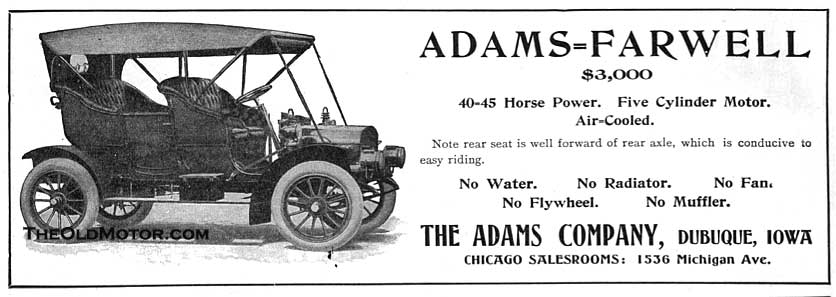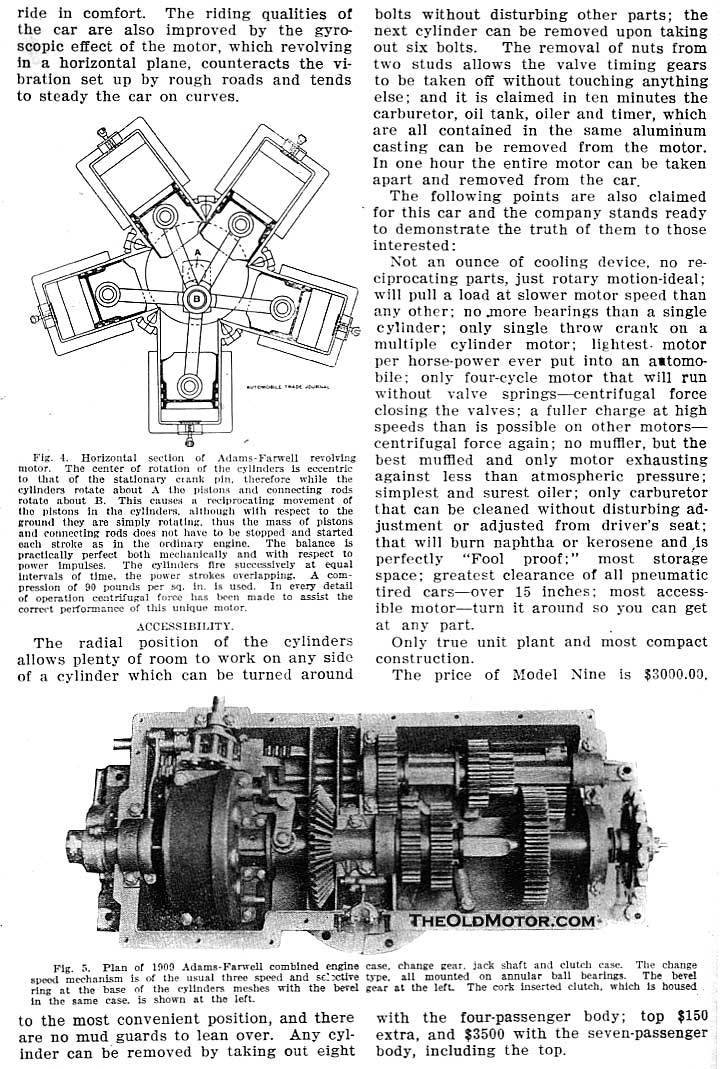Adams-Farwell
The Adams - Farwell was an innovative, US- American automobile of Dubuque, Iowa, which was produced from 1905 to 1913 by the Adams Company locally.
History
The company went from Roberts & Langworthy Iron Works produced based at 57 South Main Street in Dubuque, one that creates grave crosses and park benches. After the withdrawal of Roberts' from the company in 1883 Eugene Adams earned his share and went as secretary and manager in the company. 1885 followed the logical renaming in Langworthy and Adams Iron Works. As 1892 Langworthy also retired, was able to buy its share Eugene's brother Herbert Adams. Now, the company was reorganized as The Adams Company, Foundry and Machine Shop. In the same year the work was victim of a fire, and the company moved to new premises at East 4th Street. Now also cast-iron machine components and household appliances such as washing machines or a 1897 patented " Floor Heating Fan " were established, the warm air distributed from lower to upper rooms. 1895 Fay Oliver Farwell ( 1859-1935 ) has joined as a managing director in the company.
He soon began to experiment with internal combustion engines and designed a horizontal arrange been requested 3-cylinder rotary engine whose cylinder and crankcase horizontally turned to a standing fixed crankshaft. Inlet and outlet valves were led directly into the cylinder heads. The power is transmitted by means of bevel gears, the air cooling by the rotation of the cylinder. The idea for the star-shaped arrangement had Farwell after the observation of a steam winch; the main advantages he saw that the engine neither a flywheel still needed a cooler. In 1898 he built this engine between the front wheels of an iron- wheeled carriage. Already in the prototype Model No. 2 He built his engine but a in the rear. This approach was followed by all other Adams - Farwell. He used bicycle wheels for this second vehicle, for the third wood spoke artillery wheels. Probably similar Model No. 4 he sold to a citizen of Dubuque. Prototype No. 5 was in February 1905 at the International Auto Show Chicago (Illinois ) is shown, where orders were received for the first time. He went as a model 6 20/25 hp virtually unchanged in production. In ads was advertised with the slogan: It spins like a top.
Innovations
Apart from the engine of the Adams - Farwell had to offer more idiosyncratic solutions. The only available body variant, called Convertible Brougham, was actually a Town Brougham. Your " variable " part was a convertible seat in the bulkhead which could be open when needed. The steering lever - a steering wheel came later - could be together with attached controls remove a few simple steps and refit front of the rear seat. The practical benefit: in case of bad weather had not be driven from the unprotected front seat. The Adams Farwell had a list price of $ 2,500 and was by damaligem understanding a high end model.
1906 from the Model 6 is a Series 6; next to the famous 20/25 hp three-cylinder engine was a new Series 6 40/45 hp with a five- cylinder engine according to the same design principle and about 8 liters capacity available. Both shared a slightly longer compared to the previous chassis.
The Adams Company now provided the 20/25 hp instead of Brougham as Landaulet (probably a similar configuration with folding rear roof part) and as a 5- seater touring was sometimes called Convertible Runabout. The 40/45 hp, there was also a touring as Landaulet (both 5-seater ), as well as an extension Brougham; the latter had a longer wheelbase by about 10 cm. Striking longer was a model designated as 7-A 7- seater touring with a conventional -looking front ( without cooler ); As with other vehicles of the era was still the engine at the ancestral place in the rear. The rear seat was slightly forward, added before the rear axle. All other variants had the folding front seat. Also new was the Model 8-A Gentleman's speed roadster with the shortest chassis model year, the 40/45-hp-Motor and a frameless design, which can be regarded as precursors of the monocoque body. This sports car was around 120 km / h, then a very considerable speed.
This model diversity was completely disappeared in 1907; there was only the Model 7-A Touring, now with even longer wheelbase and a higher price.
1908 was again a year of innovations. Probably with the new model 9 50 hp, a four-speed gearbox was introduced ( most cars then had 3 courses). There were two clutches, one for the transitions 2 and 4, and one for the gears 1, 3 and the reverse. For each coupling a separate shift lever was provided; they were operated by a common lever to the steering column. Thus two transitions could select simultaneously, for example, the second and reverse gear. Was inserted them simply by operating the clutch lever each one. Instead of the steering lever with manual operation, there was now the gas pedal and steering wheel. This eliminated the true opportunity to put the steering on a different seating position. Instead, the steering column was out in a bar in front of the front seats and settled move it; the car was so true to the wishes of the driver, a left - or right-hand drive. There was this model 9 as a roadster for three when touring for seven and as Coupé also for three people. Unfortunately, now, the Roadster was built conventionally.
One last change there was for 1909. The coupe accounted for without replacement, the roadster got another seat and the Touring an even longer chassis. In this form of the Adams - Farwell was built until 1912. Then the Adams Company was on the automotive industry. From 1905 to 1913 just emerged 52 Adams - Farwell.
Model Overview
The small company brought out a pretty impressive number of models and variations, as the table shows:
In displaying 1906 Touring with "false " bonnet and the designation Model L is shown. This is probably the Model 7-A 40/45 hp; Further details could not be found.
Performance information
Performance data from this period are unclear; at that time there was still no uniform standard for the calculation. Usually, the first value on the control PS and the second on the power (hp) refers. In the U.S., most were the formulas of N.A.C.C. ( " North American Chamber of Commerce" ) or the ALAM ( " Association of Licenced Automobile Manufacturers " ) applied. The performance of the Adam Farwell 6 Model 20/25 is likely 15 to 20 kW and the model have 9 50 hp located at 35 kW.
The only surviving Adams - Farwell
The National Automobile Museum in Reno (Nevada ) - formerly Harrah Collection - owns the last remaining vehicle of the brand, a Series 6 40/45 hp Touring, spanned from Connolly Carriage & Buggy Company; with five-cylinder engine and the hinged seat forward. It participated in the Concours d'Elegance at Pebble Beach in 2011 in part and won the Charles A. Chayne Trophy for the most advanced technology of its time.
Development without Autobau
The Adams Company also developed light gyrocopter engines, the experimental models of Emile Berliner 1909/10 and J. Newton Williams 1909 drives successfully. After the abandonment of the automobile ( it is not clear how long engines manufactured ), the company has moved to the iron foundry and production of gears. Fay Farwell Adams left the Company in early 1920 and then tried to evaluate a patent for driving fairground carousels.










